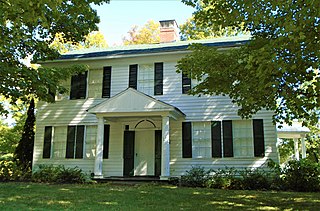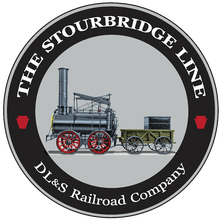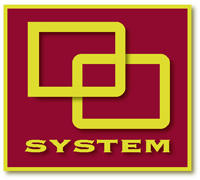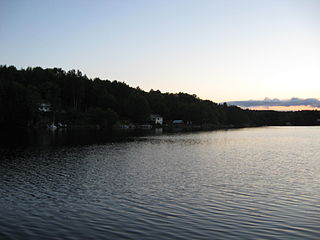
Fulton County is a county in the U.S. state of New York. It forms part of the state's Mohawk Valley region. Its county seat is Johnstown. At the 2020 U.S. census, the county had a population of 53,324. The county is named in honor of Robert Fulton, who is widely credited with developing the first commercially successful steamboat. Fulton County comprises the Gloversville micropolitan statistical area, which is included in the Capital District.

Schenectady is a city in Schenectady County, New York, United States, of which it is the county seat. As of the 2020 census, the city's population of 67,047 made it the state's ninth-largest city by population. The city is in eastern New York, near the confluence of the Mohawk and Hudson rivers. It is in the same metropolitan area as the state capital, Albany, which is about 15 miles (24 km) southeast.

Gloversville is a city in the Mohawk Valley region of Upstate New York, and the most populous city in Fulton County. Gloversville was once the hub of the United States' glovemaking industry, with over two hundred manufacturers in Gloversville and the adjacent city of Johnstown. In 2020, Gloversville had a population of 15,131.
Northampton is a town in Fulton County, New York, United States. The population was 2,670 at the 2010 census. The name comes from an original land patent. Northampton is in the northeastern corner of the county and is northeast of Gloversville.

Northville is a village in the northern part of the town of Northampton in Fulton County, New York, United States, northeast of Gloversville. The population was 993 at the 2020 census. It lies within Adirondack Park and serves as the southern terminus for the Northville-Placid Trail.

Johnstown is a city in and the county seat of Fulton County in the U.S. state of New York. The city was named after its founder, Sir William Johnson, Superintendent of Indian Affairs in the Province of New York and a major general during the Seven Years' War in North America. It is located approximately 45 miles (72 km) northwest of Albany, about one-third of the way between Albany and the Finger Lakes region to the west, in the Mohawk Valley region, within the foothills of the Adirondack Mountains.

Mayfield is a town in Fulton County, New York, United States, northeast of Gloversville and Johnstown. The town contains a village also named Mayfield. The population of the town was 6,495 at the 2010 census.

The Mohawk Valley region of the U.S. state of New York is the area surrounding the Mohawk River, sandwiched between the Adirondack Mountains and Catskill Mountains, northwest of the Capital District. As of the 2010 United States Census, the region's counties have a combined population of 622,133 people. In addition to the Mohawk River valley, the region contains portions of other major watersheds such as the Susquehanna River.

The Great Sacandaga Lake is a large lake situated in the Adirondack Park in northern New York in the United States. The lake has a surface area of about 41.7 square miles (108 km2) at capacity, and the length is about 29 miles (47 km). The word Sacandaga means "Land of the Waving Grass" in the local native language. The lake is located in the northern parts of Fulton County and Saratoga County near the southern border of the Adirondack Park. A small portion also extends northward into southern Hamilton County. The broader, south end of the lake is northeast of the City of Johnstown and the City of Gloversville. Great Sacandaga Lake is a reservoir created by damming the Sacandaga River. The primary purpose for the creation of the reservoir was to control flooding on the Hudson River and the Sacandaga River, floods which had a historically significant impact on the surrounding communities.

The J.G. Brill Company manufactured streetcars, interurban coaches, motor buses, trolleybuses and railroad cars in the United States for almost ninety years, making it the longest-lasting trolley and interurban manufacturer. At its height, Brill was the largest manufacturer of streetcars and interurban cars in the US and produced more streetcars, interurbans and gas-electric cars than any other manufacturer, building more than 45,000 streetcars alone.

The Illinois Terminal Railroad Company, known as the Illinois Traction System until 1937, was a heavy duty interurban electric railroad with extensive passenger and freight business in central and southern Illinois from 1896 to 1956. When Depression era Illinois Traction was in financial distress and had to reorganize, the Illinois Terminal name was adopted to reflect the line's primary money making role as a freight interchange link to major steam railroads at its terminal ends, Peoria, Danville, and St. Louis. Interurban passenger service slowly was reduced, ending in 1956. Freight operation continued but was hobbled by tight street running in some towns requiring very sharp radius turns. In 1956, ITC was absorbed by a consortium of connecting railroads.

The Stourbridge Line is a shortline railroad that operates 25 miles (40 km) of former Erie Lackawanna Railroad trackage between Honesdale and Lackawaxen, Pennsylvania where it connects with Norfolk Southern Railway. The line was previously owned by the Lackawaxen-Honesdale Shippers Association and operated under contract by Robey Railroads. The operation was contracted to the Morristown & Erie Railway in January, 2009; service ended in 2011. Service was resumed by the Delaware, Lackawaxen & Stourbridge Railroad (DL&S) on May 9, 2015.

New York State Route 30 (NY 30) is a state highway in the central part of New York in the United States. It extends for 300.71 miles (483.95 km) from an interchange with NY 17 in the Southern Tier to the US–Canada border in the state's North Country, where it continues into Quebec as Route 138. On a regional level, the route serves to connect the Catskill Park to the Adirondack Park. In the latter, NY 30 is known as the Adirondack Trail. Aside from the state parks, the route serves the city of Amsterdam and several villages.

The Delaware Otsego Corporation (DO) is an American railway holding company which owns the New York, Susquehanna and Western Railway and the Central New York Railroad. It is headquartered in Cooperstown, New York in Otsego County.

New York State Route 349 (NY 349) is an east–west state highway in Fulton County, New York, in the United States. The highway extends for 3.58 miles (5.76 km) across largely rural terrain from an intersection with NY 30A in the town of Johnstown to a junction with NY 30 in the town of Mayfield. The westernmost section of the route is known as East State Street Extension. NY 349 was assigned c. 1931 to the portion of its alignment between County Route 154 and NY 30. It was extended west to its present terminus in the mid-1950s after NY 148 was rerouted onto an arterial highway between Gloversville and Mayfield.

Mountain Lake is a lake situated in southern Adirondack Park in Bleecker, New York. It is located just west of Great Sacandaga Lake. The lake was called Carpenter's Lake in the 19th century. The lake contains one small island, Elmer Island, located towards the western end. There is a dam on the northwestern end of the lake. Its outlet flows into Vandenburgh Pond. During an era of economic prosperity with leather and glove manufacturing in the local communities, the lake was a popular resort area for people of Gloversville and Johnstown in the late 18th and early 19th centuries. There was at one time an electric train line that ran from the northern end of Gloversville up Bleecker Mountain to a station at the lake for vacationers. This line was owned at one time by the FJ&G RR Co.

The Bullet was a streamliner electric multiple-unit passenger car produced by the J. G. Brill Company in Philadelphia for the Philadelphia and Western Railroad (P&W) in 1931, and then similar, somewhat smaller single-unit, single-end versions were built for the Fonda, Johnstown and Gloversville Railroad in 1932. Few were sold because of the Great Depression and the public transport decline in the 1930s. However, some of the P&W cars ran for almost 60 years while later being under SEPTA.

Nicholas Stoner was a hunter and trapper in the Adirondack Mountains of New York. He served in the Continental Army in the American Revolution and the American forces in the War of 1812. He is buried in Prospect Hill Cemetery, Gloversville, New York.
William G. Harris was an American businessman and politician from New York.


















